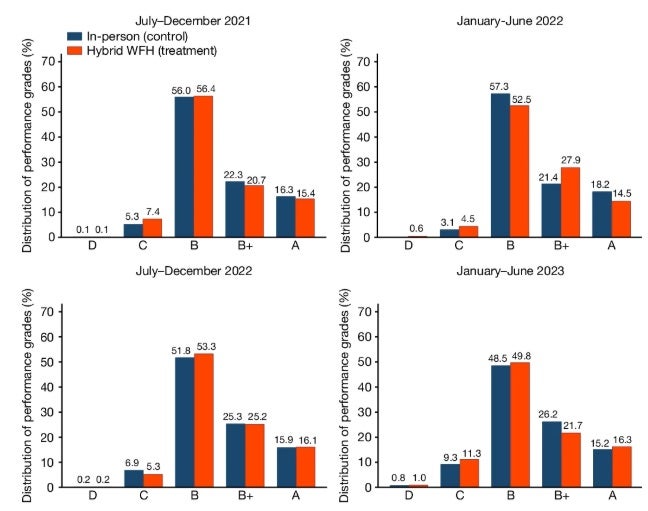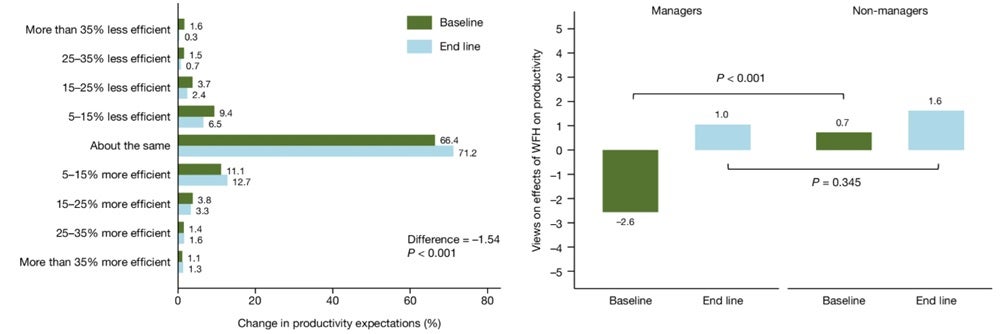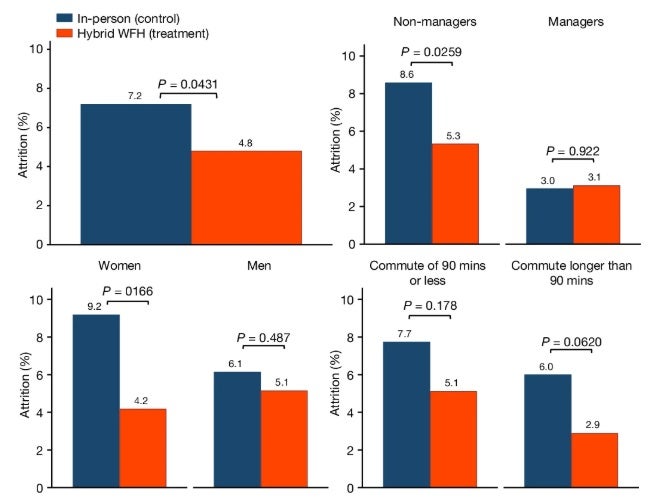The business case for hybrid work: Focus on profit (not productivity)
Research shows hybrid work arrangements boost profitability through reduced turnover without sacrificing productivity, contradicting return-to-office mandates
The covid-19 pandemic triggered an unprecedented global experiment in remote work, abruptly shifting millions of employees from offices to their homes virtually overnight. The initial surge of full-time remote work has given way to hybrid arrangements, with employees dividing their time between home and office settings.
This shift represents more than a temporary adaptation – it marks a significant and permanent transformation in how work is done around the world. “While most societal changes resulting from the covid-19 pandemic proved temporary, perhaps the most permanent behavioural change has been working-from-home and hybrid working,” said Frederik Anseel, Professor of Management and Dean of UNSW Business School.
Five years after the pandemic, he observed that data indicates relatively stable levels of hybrid working across the world – but this shift has not been uncontested. Ever since hybrid working became popular through the pandemic and was depicted as a “work revolution”, he pointed to a strong pushback from some employers to get people back into the office: “a so-called ‘counter-revolution’,” he said.
“The push to return to the office comes in waves and has been based on a range of arguments and claims. Early on, people observed that social cohesion and networking is an important part of innovation and team collaboration and some of the richness of human connection may get lost when working from home.”
Others, such as JP Morgan CEO Jamie Dimon, have criticised people working from home as being less productive or have even accused them of coasting. “Sometimes, managers felt uncomfortable that they could not monitor and control employees working out of their line-of-sight, and these managers sometimes have called for a return to the office,” said Prof. Anseel.

“Large tech companies seemed like the early champions of working from home, but of late, as part of a broader culture counter movement have also started calling people back to the office. Finally, voices outside companies, often from government have pushed for bringing people back to the office to preserve the livelihoods of CBDs and city centres and countering the plummeting values of office real estate.”
Whatever the debate and the underlying drivers of these positions, parties on each side of the debate have used their own data and statistical claims about to convince each other. “In the midst of the storm stands Nick Bloom’s research group, which has collected objective data on working from home and productivity. Using objective data, he has been one of the few voices of reason, always nuanced and evidence-based and he has helped us to understand that working from home (WFH) is likely here to stay, what we can realistically expect and under what conditions it helps productivity,” he said.
What does the research say?
Firms pushing employees to return to the office frequently cite productivity and career progression concerns as necessitating the move away from remote work models. But Prof. Bloom’s research shows these fears may be unfounded, while mandating in-office work risks hurting firms’ profitability and bottom lines. Having researched hybrid work models extensively, Prof. Bloom, the William D. Eberle Professor of Economics at Stanford University, found such models have little to no positive or negative effects on productivity.
Instead, there are positive effects on profitability through higher employee retention rates, which he argues should prompt companies to make evidence-based decisions about where they expect employees to work. “The evidence shows that hybrid is about as productive as fully in person,” Prof. Bloom told BusinessThink. “Once you have three days a week in the office, that is typically enough mentoring, innovation and culture time. These are better in person, but you do not need all five days a week in person.

“More importantly, though, is the question of what is best for profitability. Hybrid clearly wins here as it reduces turnover rates, which are hugely expensive. So, I would urge business leaders to go for the most profitable approach, not the most productive,” said Prof. Bloom, who also serves as a Senior Fellow of the Stanford Institute for Economic Policy Research.
Profitability over productivity
Return-to-office (RTO) mandates have been gaining attention as high-profile companies, particularly tech leaders such as Meta and Google, seek to return their workforces to in-office attendance following the pandemic-driven move to remote work. Government-level mandates are also on the table, with the Trump administration ordering US federal government employees to return to the office. With a federal election coming up in Australia, the Liberal Party’s leader, Peter Dutton, has positioned himself as a pro-RTO candidate, while the Labor Party’s leader, Anthony Albanese, has affirmed his support for more flexible WFH arrangements.
Meanwhile, most employees prefer a hybrid work model, rather than fully WFH or in-office, according to Prof. Bloom’s research, which shows the ability to work hybrid is worth as much as 8% more pay for employees. He argues that companies trying force the WFH genie back into the bottle based on productivity concerns are missing the bigger picture.
In a research paper, Hybrid working from home improves retention without damaging performance, he and his co-authors examined how Shanghai-based technology company Trip.com’s implementation of a hybrid model affected employee retention, productivity and career development. They found that offering hybrid work reduced quit rates by a third, saving Trip.com millions in training and HR needs, with no substantial effect on productivity.

According to the paper, there are limitations to previous research showing fully remote work to have negative effects on productivity, including the fact that most employees who work from home do so on a hybrid, not full-time, schedule. In addition, this research has typically focused on employees working on independent, repetitive tasks in call centre and data entry roles, whereas employees who regularly work from home are mostly university graduates in creative team jobs.
The Trip.com study, therefore, focused on productivity effects of university-graduate employees in creative team roles working from home two days per week. The researchers found no effect on productivity. Moreover, employees saved 60 minutes on commuting and nine minutes on personal grooming time each day they worked from home, reducing weekly commutes by an hour and a half, on average. By a large margin, most used that time to do more work on their job.

“In our Trip.com study, we found turnover fell by 33%, which saved the firm many millions of dollars a year on recruitment and retention, making hybrid highly profitable,” Prof. Bloom said. In this context, forcing a return to office on productivity grounds is “kind of like Amazon using Ferraris to deliver food – they may be faster, but they are so expensive that it’s not good business”.

Driving the return-to-office push
Historically, time spent working from home doubled every 15 years, reaching 4.7% before jumping to more than 60% early in the COVID-19 pandemic. The rate has been stabilising at about 28% since 2023, even though online shopping, for example, has returned to its pre-pandemic trend.
This shift, while abrupt, was underpinned by technological advances and societal changes that have been taking place since long before the pandemic, according to Iva Durakovic, a lecturer in the School of Built Environment at UNSW School of Arts, Design & Architecture. She believes these long-term changes mean reversing the shift to WFH and hybrid working will be difficult – even if that’s what large corporations want.
“Anywhere you’ve got a mobile device connection to the cloud has been the place of work for a long time, even prior to the pandemic,” she said. “What’s shifted is that, being forced into remote work through lockdowns, it became more accessible and, on a larger scale, gave everybody permission and experience. And I really don’t think that once that can has been opened up, we’re easily going to close it again – nor should we.”
Prof. Bloom – who co-founded WFH Research and WFH Map and has carried out the Survey of Working Arrangements and Attitudes since May 2020 – said there are essentially three camps of organisations driving the push back to the office. “One set of companies are pushing five-day RTOs in order to drive down headcount; Amazon would be an example of this, as is the US federal government. The hope is employees will quit,” he said.
“Another group has leaders that believe full-time office attendance drives performance, for example, JPMorgan and Goldman Sachs. And a third group is the real estate industry, which wants to set an example of return to office,” he added, noting that there is a close inverse match between WFH and office occupancy data.
Changing cities, flawed workspaces
However, Ms Durakovic pointed out that, even before COVID, office occupancy rates were dropping and were not at “these huge numbers that everyone seems to have in their minds” when arguing that remote work is hurting cities’ central business districts (CBDs).
Moreover, she said, the focus on getting ‘bums at desks’ has become unsustainable from a worker and social perspective, regardless of what it means for commercial property values and institutional investors. For someone earning $70,000 a year, when their commuting and day-in-the-office costs are approaching $13,000 a year, commuting to work is no longer viable.

“We are in a corporate real estate crisis, definitely, but trying to just force a square peg into a round hole is not going to solve the problem,” she said. “Hopefully, we will start to understand that the system of work and workplaces as we knew them has shifted and largely broken, so we need to find new metrics of success and new design approaches, rather than just trying to mandate what we did before.”
Ms Durakovic argues that there were “fundamental errors” in the quality of the workplace environment before people moved to remote work and that these had their own implications for productivity. “They haven’t been addressed, nor have they been fixed,” she said. “Now, you’re trying to mandate people who, by and large, through remote working, have been able to finally choose the best space to do the work they need to do. That has huge productivity benefits.
“People want to be together, but not above safety and comfort. If I’m comfortable, physically, functionally and psychologically, I’m going to feel I belong, be much more productive and produce much better work. That’s a clear baseline for the productivity argument – in trying to force people back, you need to look firstly at the quality of environment and amenity you’re forcing them back to and whether they're actually serving the purpose for which you want them there.”
Hybrid working and workforce diversity
While RTO mandates gain attention, other businesses are committing to more flexible and hybrid approaches over policies they view as enabling micromanagement, citing benefits such as improved workforce diversity and employee happiness. For example, Spotify recently announced it would continue allowing remote work, stating that “our employees aren’t children” while Airbnb has actively embraced a “live and work anywhere” policy.
Read more: How BVN is striking the right balance with hybrid working
Indeed, for most professionals, fully in-person work remains rare; instead, so-called organised or coordinated hybrid models, whether at the company or team level, appear to be emerging as the dominant model, according to Prof. Bloom. This trend reflects the trade-offs generally accepted to be inherent in remote work, particularly involving lost innovation and mentoring opportunities, recognising the importance of at least some in-person collaboration time.
Moreover, data suggest hybrid and WFH models can help support workforce diversity in race, gender, age, politics, and religion; the desire for flexibility remains strongest among underrepresented groups. They are also expanding the labour supply: disability employment has soared since the pandemic, with two-thirds of the increase coming from WFH-friendly occupations, and employment rates have risen across gender, age, education and race.
Ms Durakovic, who specialises in the design, behavioural impacts and phenomenology of workplace environments, cites these issues in arguing that organisations have more work to do on their side of the equation before they can expect a full return to office. “Until we solve some of those structural issues and problems with city congestion, cost of living, all of that, remote work and flexibility make life manageable for a lot of people,” she said.
“They can juggle cheaper caring options and reduce the cost per visit to the office, both in monetary terms as well as personal and cognitive resources. There are many aspects to it, but, ultimately, flexibility enhances our well-being through the fact that we can juggle life better with work within the circumstances we’ve got.”

The ability to work from home has also prompted a notable increase in women’s workforce participation, and it has halved the child penalty for women, with the decrease in hours worked after birth 50% less in WFH-friendly occupations.
As a result, five-day RTO mandates will likely affect firm demographics, Prof. Bloom explained. “In particular, women with young children, who are typically in the manager age range, will be most impacted by this,” he said. “So, indeed, in industries like technology and finance which can have low shares of female employees, particularly in management, five-day RTOs can reduce diversity.”
Navigating a hybrid work future
Prof. Bloom’s belief that hybrid models with two days a week working from home will outlast return-to-office mandates stems in part from advancements in WFH-related technology, which is improving at an accelerating pace. He predicts a “Nike swoosh” trend of long-run growth for remote work that he believes will benefit firms, employees and society.
“Longer-run improved technology is going to start to increase rates of working from home again,” he said. “It was increasing steadily from 1965 to 2019 as technology continuously got better, and that long-run trend will reassert within the next five years. This is like the Nike swoosh – a rapid drop, a stabilisation and then a longer-run steady growth.”
For successful hybrid models, coordination is essential, enabling employees to be in the office mostly on the same days, preferably in spaces designed to focus on social co-working, according to Prof. Bloom. “Five years from now, we will have higher levels of WFH as the technology will have improved considerably. Over the last 30 years, improved technologies like personal computers, the internet, the cloud and video calls have made WFH substantially better and more common – and that progress will only continue,” he said.
Subscribe to BusinessThink for the latest research, analysis and insights from UNSW Business School
The WFH revolution has ignited a broader and important change in leadership and people management, which will shift away from measuring work in hours, according to Prof. Anseel “WFH was the first step – who cares if you only need four hours of work, that others might require eight hours for? It is about contribution and output,” he said.
This evolution will be further amplified by the use of AI, Prof. Anseel predicted. “While the time of consultants, lawyers or accountants use to be measured and billed in hours, market analysis or making a PowerPoint with a strategic analysis might only take 10 minutes with AI deep research. So, the challenge is for businesses to adapt and think how they can design performance measurement models that are no longer focused on how many hours someone brings to the job, and certainly not only about where that contribution is being delivered,” he concluded.
